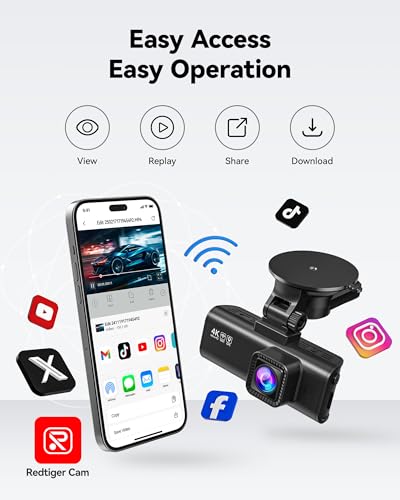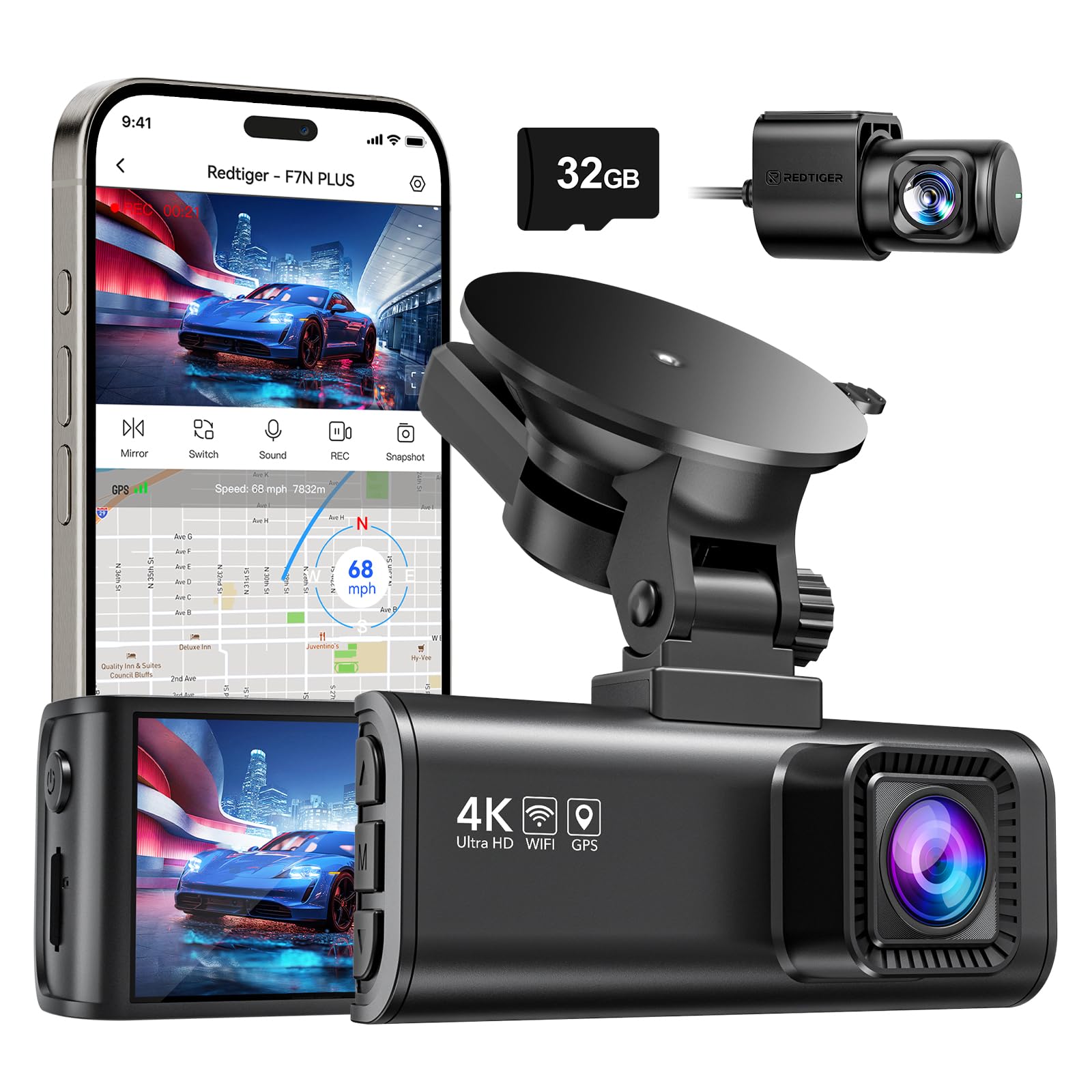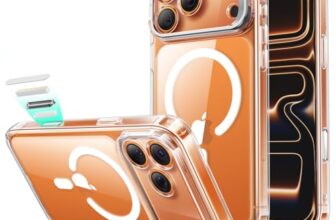REDTIGER F7NP Dual Dash Cam Technical Review: The Definitive Eyewitness for the Modern Driver
Introduction: The Age of the Indisputable Digital Witness
In the complex and often unpredictable environment of modern roads, the need for an unbiased, high-fidelity eyewitness has transitioned from a luxury to an absolute necessity. A dash camera is no longer just a gadget for tech enthusiasts; it is an essential piece of safety equipment, a silent partner that provides irrefutable evidence in the event of a collision, documents unexpected events, and offers a profound sense of security every time you get behind the wheel. However, the market is flooded with a bewildering array of options, many of which fail to deliver on their promises, offering grainy video, unreliable operation, and a frustrating user experience. It is into this crowded space that the REDTIGER F7NP Front and Rear Dash Cam emerges, not merely as another competitor, but as a definitive, all-in-one solution that democratizes premium, flagship-level features.
This is not a basic, entry-level recorder; it is a sophisticated, feature-packed surveillance and data-logging system for your vehicle. REDTIGER has engineered the F7NP with a philosophy of comprehensive coverage and uncompromising clarity. It is built upon a foundation of a true 4K Ultra HD front sensor, delivering a level of detail that can be the critical difference in an insurance claim or legal dispute. This visual prowess is not limited to daylight; it is supported by a sophisticated low-light imaging system designed to pierce the darkness with clarity. But the F7NP’s intelligence goes far beyond its lenses. It integrates a full suite of modern connectivity and data features, including built-in Wi-Fi for seamless smartphone integration and a GPS module for logging crucial speed and location data. This entire technological suite is wrapped in a user-friendly package that includes essential safety features like a G-sensor for automatic incident recording and a 24-hour parking monitor for around-the-clock protection. Its best-selling status for 2025 is a direct result of this powerful value proposition: it delivers a complete, professional-grade feature set at a price point that makes superior safety and security accessible to every driver. And with a limited-time 43% discount, its position as a market leader is undeniable.
In this exhaustive technical review, we will perform a granular dissection of the technologies that define the REDTIGER F7NP. We will analyze the physics of its optical systems, deconstruct the algorithms behind its WDR and night vision capabilities, evaluate the real-world performance of its Wi-Fi and GPS integration, and explore the critical safety functions that make it a reliable digital witness. This is a deep dive for the discerning driver who understands that when it comes to evidence, there is no substitute for clarity and reliability.

A Deep Dive into the Key Features: A Component-by-Component Technical Analysis
The REDTIGER F7NP’s market-leading success is the direct result of a focused design that prioritizes high-resolution imaging, low-light performance, and a complete, user-friendly feature set. Let’s analyze the core components from a technical perspective.
-
The Foundation of Evidence: 4K+1080P Dual Recording
The single most critical specification of a dash camera is its video resolution, as this directly determines its ability to serve its primary function: capturing indisputable evidence. The F7NP excels in this domain by offering a high-performance dual-camera system. The front camera records in a true **Ultra HD 4K (3840*2160P)** resolution. From a technical standpoint, a 4K image contains four times the number of pixels as a standard 1080p Full HD image. This exponential increase in pixel density is not a gimmick; it is the key to capturing “key details like road signs, vehicle number plates etc.” with a level of clarity that is often the deciding factor in an insurance claim or police report. It allows for significant digital zoom on recorded footage without the image devolving into a pixelated mess, ensuring that critical, fine details are legible.
This is complemented by a **Full HD 1080P rear camera**. While not 4K, 1080p is more than sufficient for clearly capturing the events happening behind the vehicle, providing crucial context in the event of a rear-end collision. The system’s coverage is further enhanced by its wide-angle lenses. The **170-degree front and 140-degree rear angles of view** create an expansive field of vision that significantly reduces blind spots. A 170° front view is wide enough to capture multiple lanes of traffic and the entirety of an intersection, ensuring that a vehicle entering your lane from the side is captured on video. This comprehensive, high-resolution coverage in front and behind is the bedrock of the F7NP’s ability to “retain and present evidence” during unexpected circumstances.

-
Piercing the Darkness: Superior Night Vision Technology
A significant percentage of driving incidents occur in low-light conditions. The F7NP is engineered with a multi-component system to deliver “superior night vision.” This begins with its “excellent optical lens,” which features an **ultra-large F1.5 aperture** and a **6-layer glass construction**. From an optical physics perspective, the aperture (f-number) is the opening that allows light to reach the image sensor. A low f-number like f/1.5 represents a very large opening, which allows the lens to gather a massive amount of ambient light. This is the single most important hardware factor for strong low-light performance. The 6-layer glass lens, likely with multi-coating, helps to maximize light transmission and reduce internal reflections and flare from sources like headlights and streetlights.
This powerful optical hardware is paired with advanced image processing technology, specifically **HDR (High Dynamic Range) and WDR (Wide Dynamic Range)**. Both technologies are designed to solve the problem of high-contrast nighttime scenes. WDR works by taking multiple exposures of the same scene at different levels (e.g., a short exposure to capture the detail in bright headlights, and a long exposure to capture detail in dark shadows) and then computationally merging them into a single, balanced frame. HDR performs a similar function, often with more advanced tone mapping. The result is an image where bright areas are not “blown out” into a white glare and dark areas are not “crushed” into an indecipherable black mass. This technology is what allows the camera to “capture key details clearly under low light conditions,” such as a license plate that is being illuminated by your own headlights, a detail that lesser cameras would wash out completely.

-
Seamless Integration: Built-in Wi-Fi and Smart App Control
The F7NP moves beyond the limitations of a standalone device with its **built-in Wi-Fi** functionality. From a technical standpoint, the camera creates its own local Wi-Fi hotspot. This allows you to connect your smartphone directly to the dash cam without needing an external internet connection. This wireless link is the gateway to the **”Redtiger Cam” app**, which is available for both iOS and Android devices. The app transforms your smartphone into a powerful command center for the dash cam. Its key functions include:
- Live View: You can see a real-time feed from both the front and rear cameras, which is incredibly useful for initial setup and aiming the lenses correctly.
- Playback: You can browse, stream, and play back any of the video files stored on the camera’s memory card directly on your phone’s screen. This is far more convenient than having to remove the small SD card and find a computer to view the footage.
- Management: You can change all of the dash cam’s settings—such as resolution, loop recording duration, G-sensor sensitivity, and more—through the app’s intuitive interface.
- Download and Share: Most importantly, you can select and download critical video files directly to your phone’s storage. From there, you can easily edit them or share them with police, insurance agents, friends, or family with a single click. This feature makes managing and utilizing your footage incredibly simple and efficient.

-
The Data Layer: Integrated GPS for Corroborating Evidence
The F7NP includes a **built-in GPS module**, a feature that adds a critical layer of verifiable data to your video evidence. It is important to note that this is not a navigation GPS. Its sole function is to continuously receive signals from GPS satellites to log crucial telemetry data. This data is then embedded into the video file’s metadata stream. The logged information includes:
- Real-time Speed: Your vehicle’s speed is accurately recorded and can be optionally overlaid on the video footage itself.
- Location Coordinates: The precise latitude and longitude are logged, pinpointing the exact location of your vehicle at all times.
- Driving Route: When the data is played back using the dedicated **Windows and Mac GPSPlayer** software, it can plot your entire driving route on a Google Maps interface, synchronized with the video playback.
This telemetry data serves as powerful “further additional evidence if an accident occurs.” It can be used to prove you were not speeding, to confirm your exact location at the time of an incident, and to provide a comprehensive, data-rich record of events for any legal or insurance proceedings.

-
Always on Guard: Reliable Features for Accident Recording
The F7NP is engineered with a suite of essential “set it and forget it” technologies to ensure that critical moments are always captured and preserved. **Loop Recording** is the foundation of this system. The camera records video in short, continuous segments (e.g., 1, 3, or 5 minutes). When the memory card (a 32GB card is included) becomes full, the camera automatically overwrites the oldest, unprotected video file. This ensures that the camera never stops recording because of a full card, providing continuous, uninterrupted surveillance.
The key to preserving evidence is the **G-sensor** (gravity sensor). This is a built-in accelerometer that is constantly measuring the G-forces acting on the vehicle. In the event of a sudden, sharp change in these forces—such as from a collision, an emergency braking maneuver, or a significant impact—the G-sensor is triggered. When triggered, it automatically takes the currently recording video file and “locks” it. This locked file is placed in a protected folder on the memory card and cannot be overwritten by the loop recording function, guaranteeing that the crucial moments leading up to, during, and after an incident are safely preserved.
For protection when the vehicle is parked, the F7NP includes a **24-hour parking monitor** with a time-lapse function. When activated, the camera will continuously record at a very low frame rate (e.g., one frame per second). This allows it to document any activity around the car over a 24-hour period using a fraction of the storage space and power. It’s important to note that this feature requires a continuous power supply, which is only possible with the installation of an optional **hardwire kit** that connects the camera directly to the car’s fuse box.

Pros: The Undeniable Technical Strengths
- Flagship-Level 4K Video Clarity: The front camera’s Ultra HD 4K resolution provides exceptional detail, which is critical for capturing license plates and other key evidence.
- Superior Low-Light and Night Performance: The combination of a large F1.5 aperture lens and advanced WDR/HDR image processing delivers clear, balanced footage in challenging nighttime conditions.
- Comprehensive Feature Set: The integration of dual-channel recording, built-in Wi-Fi, and built-in GPS provides a complete, all-in-one surveillance and data-logging solution.
- Seamless Smartphone Integration: The user-friendly app makes it incredibly easy to view, manage, and download footage without ever needing to remove the memory card.
- Essential Automated Safety Features: The combination of loop recording and an impact-detecting G-sensor ensures that the camera is always recording and that crucial incident files are automatically protected.
- Excellent Value Proposition: Offers a suite of premium features, including an included 32GB memory card and an 18-month warranty, at a highly competitive and accessible price point.

Cons: Important Technical Considerations and Limitations
- Hardwire Kit Required for Parking Mode: The 24-hour parking monitor function cannot be used out of the box with the standard cigarette lighter adapter; it requires the separate purchase and installation of a hardwire kit.
- Included SD Card is Small for 4K: While the inclusion of a 32GB card is a nice bonus, it will fill up relatively quickly when recording in 4K. Users who want to store more footage before it is loop-recorded will need to upgrade to a larger-capacity, high-endurance microSD card.
- Use of Supercapacitor vs. Battery: (Common technical point) The camera likely uses a supercapacitor instead of a lithium-ion battery for power. While this is a major safety and durability advantage (it’s far more resistant to extreme heat and cold), it means the camera has almost no internal battery life and will shut down almost instantly when disconnected from power.
- Rear Camera is 1080p, Not 4K: While the front camera is 4K, the rear camera is 1080p. This is a common and reasonable trade-off for a system in this price range, but it is a point to be aware of.
Conclusion: The Definitive Choice for High-Tech, High-Value Vehicle Security
The REDTIGER F7NP Dual Dash Cam is a truly exceptional product that masterfully balances a flagship-level feature set with an incredible value proposition. It is a powerful and definitive solution for any driver who understands the critical importance of having a reliable digital witness on the road. The performance of its core imaging system is outstanding, delivering the kind of crisp 4K detail and clear night vision that can make all the difference when it matters most. What elevates the F7NP to a true best-in-class status, however, is that it wraps this excellent video quality in a complete and user-friendly ecosystem. The seamless integration of Wi-Fi for app control and GPS for data logging transforms it from a simple recorder into a sophisticated surveillance and evidence-gathering tool.
While the requirement of a separate hardwire kit for parking mode is a standard caveat in the industry, the out-of-the-box experience for driving is flawless. The automated safety features provide a true “set it and forget it” peace of mind, ensuring that the camera is always on guard. For the daily commuter, the professional driver, the road trip enthusiast, or any family looking to add a powerful layer of security and accountability to their vehicle, the REDTIGER F7NP is not just a top choice; it is arguably the smartest investment you can make in your driving safety. It has rightfully earned its best-selling status and our highest and most enthusiastic recommendation.
Frequently Asked Questions (FAQs)
- Q1: What is the main technical benefit of 4K resolution on a dash cam versus 1080p?
- A: The primary benefit is detail and legibility at a distance. A 4K image has four times the pixels of a 1080p image. This means that when you need to identify a license plate number on a car that is 50-100 feet ahead of you, you can digitally zoom into the 4K footage and the numbers will remain clear and readable. On 1080p footage, the same license plate would likely be an unreadable, pixelated blur.
- Q2: Do I need to be connected to my home Wi-Fi or have an internet connection for the app to work?
- A: No. The dash cam creates its own Wi-Fi hotspot, like a personal router. Your phone connects directly to the dash cam’s Wi-Fi signal. This allows you to transfer files and manage the camera even if you are in a remote area with no cellular service or internet access.
- Q3: Why is a hardwire kit required for the 24-hour parking monitor?
- A: Most cars’ cigarette lighter sockets only provide power when the car’s ignition is on. To monitor your car while it is parked and turned off, the dash cam needs a continuous source of power. A hardwire kit connects the camera directly to your car’s fuse box, tapping into a circuit that is “always on,” like the one for your interior lights. These kits also have a voltage cutoff to prevent the dash cam from completely draining your car’s battery.
- Q4: What is a G-Sensor and how does it work to protect my files?
- A: A G-Sensor, or gravity sensor, is a type of accelerometer. It’s a tiny chip that detects sudden changes in force or direction. If it detects a sharp impact, like from a collision, it sends a signal to the dash cam’s processor. The processor then immediately “locks” the current video file that is being recorded, moving it to a special folder where it cannot be automatically overwritten by the loop recording function, thus preserving the crucial evidence.
- Q5: Does this camera use a battery or a supercapacitor? What’s the difference?
- A: High-quality dash cams like this one typically use a **supercapacitor** instead of a lithium-ion battery. This is a critical safety and durability feature. Supercapacitors are far more resistant to extreme temperatures. They will not swell or fail in a hot car during the summer, nor will their performance degrade significantly in a freezing winter, unlike a standard battery. This makes the camera much more reliable for use in a vehicle that experiences wide temperature swings.
- Q6: How much recording time can I get on the included 32GB card before it starts looping?
- A: The recording time depends on the resolution. For a 4K front and 1080p rear recording, a 32GB card will typically hold approximately 2 to 3 hours of footage. After that, the loop recording function will begin to overwrite the oldest files. For users who want to keep a longer history of their drives, upgrading to a larger, high-endurance 128GB or 256GB microSD card is highly recommended.
See more posts in the category Cameras.







